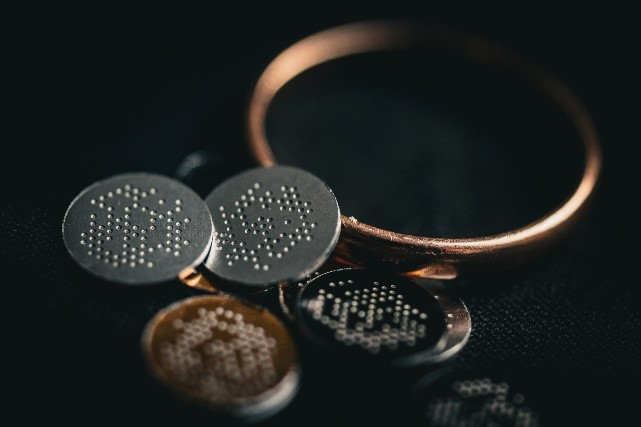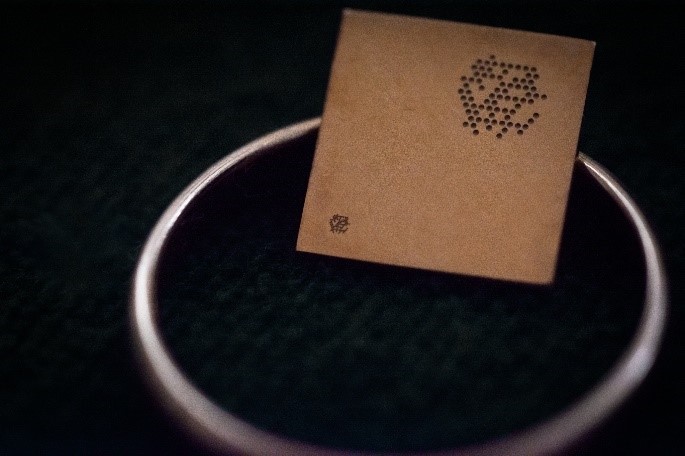Nano-marking, which links an object to its digital passport stored in an ethical blockchain, is sure to appeal to the watchmaking and jewellery industry – and not just the big brands. Ocode and Phasis celebrate their union at EPHJ…
This is the story of a Nantes-based start-up, focused on traceability and anti-theft solutions, which hits it off with a University of Geneva spin-off that has already played a part in the history of the famous Poinçon de Genève (Geneva Seal). The two get on famously, working non-invasively against a backdrop of ethical values.
A couple committed to uniqueness

One, European company Ocode, was initially looking for highly visible stickers to affix to those public bicycles that have a tendency to disappear, and then in much smaller and more subtle formats than stickers for use on any objects liable to be stolen. It came up with a hexagonal key resembling a cloud of points, ideal for all kinds of marking applications. This key opens doors like a digital fingerprint, giving access to a picture of the object and its manufacturing and life cycle, and even advice on how to use it. In short, all the features that make it unique. The technique requires a mastery of mathematics and involves creating codes, similar to QR codes with their improbable and seemingly illogical shapes. The whole thing is deposited by means of a non-fungible token (NFT) in a tamper-proof safe, that of a private blockchain, which uses little energy and, most importantly, isn’t tempting to speculators.
The other, Phasis, a little polished jewel in the University of Geneva’s crown, had developed cutting-edge technology in the form of a contactless nano-engraving system. Involving no physical trauma, it works on any type of metal, even the most precious. According to French business and technology magazine L’Usine Nouvelle, it was inspired by “tunnelling microscope technology, diverted from its original function to make a metal engraving tool. This technique combines electrochemical machining and electroerosion to remove the material with an electrical discharge from a wire electrode – similar to the tip of a tunnelling microscope. And that’s not all: a gel containing metallic nanoparticles bathes the surface and the electrode, so that the discharge also causes these nanoparticles to melt. These are then deposited in the form of an alloy on the surface of the shape, which is hollowed out at the same time.”

Moreover, it can be customised. “By adjusting the composition of the alloy, the company can add robustness, better tribological properties, chemical resistance, or even a unique roughness that acts as a fingerprint.” Phasis director and co-founder Jorge Cors adds: “It creates a unique chemical signature, similar to that of banknotes containing europium oxides for identification purposes. […] Unlike lasers, our nanostructuring solution can produce sharp engravings more than a millimetre deep and with a lateral spatial resolution of around 100 nanometres.”

A point cloud that leaves nothing to chance
With this generation of sharp, precise and stylish engravings, potentially even readable by a smartphone lens, Phasis suddenly found its digital missing link, courtesy of Ocode. According to L’Usine Nouvelle, “the identification process involves Ocode creating a hexagonal code made up of tiny cells”. Using its technique, Phasis then engraves each cell of the code with thousands of micro-discharges on the item to be identified. “The ocode can be compared to a unique door key, modified by the presence or absence of cells,” explains Nathan Girard, Innovation Projects Manager at Ocode. “We set a maximum number of cells, just as several squares are needed for a QR code, in order to generate an almost ‘infinite’ number of ocodes.”
The happy couple will be cohabiting for the first time at EPHJ. Wedded in the cause of anti-counterfeiting, they intend to make their presence felt in sectors including jewellery, watchmaking, leather goods, defence, medicine, automotive and aerospace. Taking a first look around and your first selfies from Palexpo? Good idea, because this new-age digital hallmark photographs well through smartphone camera lenses!
www.phasis.ch / www.ocode.fr
Joël A. Grandjean
